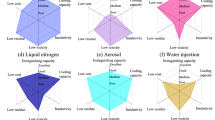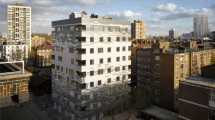Abstract
Ambient wind is an important environmental factor in fire safety research. However, little work has been conducted to investigate the effect of ambient wind on the flame retardancy of intumescent fire-retardant coatings. In this work, steel plates coated with a commercially available intumescent fire-retardant coating were applied for the fire resistance test. External heat flux and ambient wind speed were set constant to simulate actual fire scenarios. The swelling evolutions of intumescent coatings with/without wind effect were recorded. The morphology, structure, thermal stability, and impact resistance of chars at the front end and the rear end were analyzed. Results showed that intumescent coatings undergo a non-uniform swelling process with wind effect. The evolutions of coating thickness, coating surface temperature, and steel temperature can be divided into three stages. Ambient wind affects the coating surface temperature by convective cooling and char oxidation reaction. The maximum coating surface temperature at the front end is 25 °C higher than the rear end. Besides, ambient wind accelerates (and decelerates) the char oxidation reaction at the front (and the rear) end, resulting in the coating thickness at the front end growing slower than the rear end. The char at the front end is thin and condensed with good impact resistance and thermal stability. However, its poor thermal insulation accelerates the steel temperature increase at the front end and promotes the failure of intumescent coatings. Thus, ambient wind decreases the flame retardancy of intumescent fire-retardant coating.













Similar content being viewed by others

References
Fire and Rescue Bureau of Ministry of Emergency Management of China, National fire and emergency response in 2020. https://www.119.gov.cn/article/41kpo4CAQyv. Accessed 1 Feb 2021.
Lucherini A, Maluk C. Intumescent coatings used for the fire-safe design of steel structures: a review. J Constr Steel Res. 2019. https://doi.org/10.1016/j.jcsr.2019.105712.
Fan F, Xia Z, Li Q, Li Z, Chen H. Thermal stability of phosphorus-containing styrene–acrylic copolymer and its fire retardant performance in waterborne intumescent coatings. J Therm Anal Calorimetry. 2013;114(3):937–46. https://doi.org/10.1007/s10973-013-3099-y.
Jun-wei G, Zhang GC, Dong SL, Zhang QY, Kong J. Study on preparation and fire-retardant mechanism analysis of intumescent flame-retardant coatings. Surf Coat Technol. 2007;201(18):7835–41. https://doi.org/10.1016/j.surfcoat.2007.03.020.
Bahrani B, Hemmati V, Zhou A, Quarles SL. Effects of natural weathering on the fire properties of intumescent fire-retardant coatings. Fire Mater. 2018;42(4):413–23. https://doi.org/10.1002/fam.2506.
Yan L, Zhisheng X, Wang X. Synergistic flame-retardant and smoke suppression effects of zinc borate in transparent intumescent fire-retardant coatings applied on wood substrates. J Therm Anal Calorim. 2018;136(4):1563–74. https://doi.org/10.1007/s10973-018-7819-1.
Li Y, Feng Y, Zhisheng X, Yan L, Xie X, Wang Z. Synergistic effect of clam shell bio-filler on the fire-resistance and char formation of intumescent fire-retardant coatings. J Mater Res Technol. 2020;9(6):14718–28. https://doi.org/10.1016/j.jmrt.2020.10.055.
Lucherini A, Hidalgo JP, Torero JL, Maluk C. Influence of heating conditions and initial thickness on the effectiveness of thin intumescent coatings. Fire Saf J. 2021;120:103078. https://doi.org/10.1016/j.firesaf.2020.103078.
Zhang F, Chen P, Wang Y, Li S. Smoke suppression and synergistic flame retardancy properties of zinc borate and diantimony trioxide in epoxy-based intumescent fire-retardant coating. J Ther Anal Calorim. 2016;123(2):1319–27. https://doi.org/10.1007/s10973-015-5094-y.
Wang LL, Wang YC, Yuan JF, Li GQ. Thermal conductivity of intumescent coating char after accelerated aging: thermal conductivity of intumescent coating char. Fire Mater. 2013;37(6):440–56. https://doi.org/10.1002/fam.2137.
Rush D, Bisby L, Gillie M, Jowsey A, Lane B. Design of intumescent fire protection for concrete filled structural hollow sections. Fire Saf J. 2014;67:13–23. https://doi.org/10.1016/j.firesaf.2014.05.004.
Bilotta A, de Silva D, Nigro E. General approach for the assessment of the fire vulnerability of existing steel and composite steel-concrete structures. J Build Eng. 2016;8:198–207. https://doi.org/10.1016/j.jobe.2016.10.011.
Bilotta A, de Silva D, Nigro E. Tests on intumescent paints for fire protection of existing steel structures. Constr Build Mater. 2016;121:410–22. https://doi.org/10.1016/j.conbuildmat.2016.05.144.
Silva DD, Bilotta A, Nigro E. Experimental investigation on steel elements protected with intumescent coating. Constr Build Mater. 2019;205:232–44. https://doi.org/10.1016/j.conbuildmat.2019.01.223.
Jimenez M, Duquesne S, Bourbigot S. Characterization of the performance of an intumescent fire protective coating. Surf Coat Technol. 2006;201(3–4):979–87. https://doi.org/10.1016/j.surfcoat.2006.01.026.
Reshetnikov IS, Garashchenko AN, Strakhov VL. Experimental investigation into mechanical destruction of intumescent chars. Polym Adv Technol. 2015;11:392–7.
Ahmad F, Ullah S, Haswina N. An investigation on thermal performance of wollastonite and bentonite reinforced intumescent fire-retardant coating for steel structures. Constr Build Mater. 2019;228:116734. https://doi.org/10.1016/j.conbuildmat.2019.116734.
Bartholmai M, Schriever R, Schartel B. Influence of external heat flux and coating thickness on the thermal insulation properties of two different intumescent coatings using cone calorimeter and numerical analysis. Fire Mater. 2003;27(4):151–62. https://doi.org/10.1002/fam.823.
Bartholmai M, Schartel B. Assessing the performance of intumescent coatings using bench-scaled cone calorimeter and finite difference simulations. Fire Mater. 2007;31(3):187–205. https://doi.org/10.1002/fam.933.
Wang J, Wang G. Influences of montmorillonite on fire protection, water and corrosion resistance of waterborne intumescent fire retardant coating for steel structure. Surf Coat Technol. 2014;239:177–84. https://doi.org/10.1016/j.surfcoat.2013.11.037.
Duquesne S, Magnet S, Jama C, Delobel R. Intumescent paints: fire protective coatings for metallic substrates. Surf Coat Technol. 2004;180–181:302–7. https://doi.org/10.1016/j.surfcoat.2003.10.075.
Zhang Y, Wang YC, Bailey CG, Taylor AP. Global modelling of fire protection performance of intumescent coating under different cone calorimeter heating conditions. Fire Saf J. 2012;50:51–62. https://doi.org/10.1016/j.firesaf.2012.02.004.
Zeng Y, Weinell CE, Dam-Johansen K, Ring L, Kiil S. Exposure of hydrocarbon intumescent coatings to the UL1709 heating curve and furnace rheology: Effects of zinc borate on char properties. Prog Org Coat. 2019;135:321–30. https://doi.org/10.1016/j.porgcoat.2019.06.020.
Ullah S, Faiz Ahmad AM, Shariff MAB. Synergistic effects of kaolin clay on intumescent fire retardant coating composition for fire protection of structural steel substrate. Polym Degradation Stab. 2014;110:91–103. https://doi.org/10.1016/j.polymdegradstab.2014.08.017.
Morys M, Häßler D, Krüger S, Schartel B, Hothan S. Beyond the standard time-temperature curve: Assessment of intumescent coatings under standard and deviant temperature curves. Fire Saf J. 2020;112:102951. https://doi.org/10.1016/j.firesaf.2020.102951.
Dong S, Xiao G, Chen C, Yang Z, Chen C, Wang Q, Lin L. Polydopamine enwrapped titanium dioxide-assisted dispersion of graphene to strength fire resistance of intumescent waterborne epoxy coating. Prog Org Coat. 2021;157:106291. https://doi.org/10.1016/j.porgcoat.2021.106291.
Yasir M, Amir N, Ahmad F, Ullah S, Jimenez M. Effect of basalt fibers dispersion on steel fire protection performance of epoxy-based intumescent coatings. Prog Org Coat. 2018;122:229–38.
Zhang T, Zhang Y, Xiao Z, Yang Z, Hehua Zhu J, Woody J, Yan Z. Development of a novel bio-inspired cement-based composite material to improve the fire resistance of engineering structures. Constr Build Mater. 2019;225:99–111. https://doi.org/10.1016/j.conbuildmat.2019.07.121.
Aziz H, Ahmad F. Effects from nano-titanium oxide on the thermal resistance of an intumescent fire retardant coating for structural applications. Prog Org Coat. 2016;101:431–9.
Puspitasari WC, Ahmad F, Ullah S, Hussain P, Megat-Yusoff PSM, Masset PJ. The study of adhesion between steel substrate, primer, and char of intumescent fire retardant coating. Prog Org Coat. 2019;127:181–93. https://doi.org/10.1016/j.porgcoat.2018.11.015.
Naik AD, Duquesne S, Bourbigot S. Hydrocarbon time–temperature curve under airjet perturbation: an in situ method to probe char stability and integrity in reactive fire protection coatings. J Fire Sci. 2016;34(5):385–97. https://doi.org/10.1177/0734904116658049.
Ahmad F, Zulkurnain ESB, Ullah S, Amir N. Effects of nano-sized boron nitride on thermal decomposition and water resistance behaviour of epoxy-based intumescent coating. J Anal Appl Pyrolysis. 2018;132:171–83. https://doi.org/10.1016/j.jaap.2018.03.002.
Dayang Y, Liang J, Han X, Zhao J. Profiling the regional wind power fluctuation in China. Energy Policy. 2011;39(1):299–306. https://doi.org/10.1016/j.enpol.2010.09.044.
Qian H, Chen S, Wang T, Cheng G, Chen X, Zhenwen X, Zeng Q, Liu Y, Yan D. Silicon nitride modified enamel coatings enable high thermal shock and corrosion resistances for steel protection. Surf Coat Technol. 2021;421:127474. https://doi.org/10.1016/j.surfcoat.2021.127474.
Morys M, Illerhaus B, Sturm H, Schartel B. Variation of intumescent coatings revealing different modes of action for good protection performance. Fire Technol. 2017;53(4):1569–87. https://doi.org/10.1007/s10694-017-0649-z.
Wang G, Yang J. Influences of molecular weight of epoxy binder on fire protection of waterborne intumescent fire resistive coating. Surf Coat Technol. 2012;206(8–9):2146–51. https://doi.org/10.1016/j.surfcoat.2011.09.050.
Yan L, Zhisheng X, Deng N. Effects of polyethylene glycol borate on the flame retardancy and smoke suppression properties of transparent fire-retardant coatings applied on wood substrates. Progr Org Coat. 2019;135:123–34. https://doi.org/10.1016/j.porgcoat.2019.05.043.
Acknowledgements
This work was financially supported by High-Tech Industry Science and Technology Innovation Leading Plan of Hunan Province (No. 2020GK2079), the Natural Science Foundation of Hunan (No.2022JJ40618), the National Natural Science Foundation of China (No. 51906261), and the Fundamental Research Funds for the Central Universities of Central South University (No. 2021zzts0767).
Author information
Authors and Affiliations
Contributions
Chuangang Fan and Zhengyang Wang were involved in conceptualization, project administration and supervision. Chuangang Fan, Long Yan, Deju Zhu, Changhong Ou and Zhengyang Wang were involved in writing—review & editing. Yuhao Li and Yuxin Gao were involved in the investigation and collected resources. Yuhao Li was involved in writing—original draft. Yuxin Gao performed validation. Long Yan, Deju Zhu, Changhong Ou and Zhengyang Wang were involved in methodology. Zhengyang Wang was involved in data curation and funding acquisition.
Corresponding author
Ethics declarations
Conflict of interest
The authors declare that they have no known competing financial interests or personal relationships that could have appeared to influence the work reported in this paper.
Additional information
Publisher's Note
Springer Nature remains neutral with regard to jurisdictional claims in published maps and institutional affiliations.
Rights and permissions
Springer Nature or its licensor holds exclusive rights to this article under a publishing agreement with the author(s) or other rightsholder(s); author self-archiving of the accepted manuscript version of this article is solely governed by the terms of such publishing agreement and applicable law.
About this article
Cite this article
Fan, C., Li, Y., Gao, Y. et al. Effect of ambient wind on the flame retardancy of intumescent coatings. J Therm Anal Calorim 147, 14329–14341 (2022). https://doi.org/10.1007/s10973-022-11593-0
Received:
Accepted:
Published:
Issue Date:
DOI: https://doi.org/10.1007/s10973-022-11593-0



